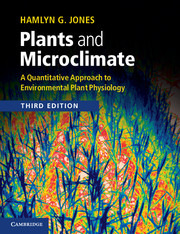Book contents
- Frontmatter
- Contents
- Preface
- Acknowledgements
- Symbols
- Main abbreviations and acronyms
- 1 A quantitative approach to plant–environment interactions
- 2 Radiation
- 3 Heat, mass and momentum transfer
- 4 Plant water relations
- 5 Energy balance and evaporation
- 6 Stomata
- 7 Photosynthesis and respiration
- 8 Light and plant development
- 9 Temperature
- 10 Drought and other abiotic stresses
- 11 Other environmental factors: wind, altitude, climate change and atmospheric pollutants
- 12 Physiology and crop yield improvement
- Appendices
- References
- Index
4 - Plant water relations
Published online by Cambridge University Press: 05 June 2014
- Frontmatter
- Contents
- Preface
- Acknowledgements
- Symbols
- Main abbreviations and acronyms
- 1 A quantitative approach to plant–environment interactions
- 2 Radiation
- 3 Heat, mass and momentum transfer
- 4 Plant water relations
- 5 Energy balance and evaporation
- 6 Stomata
- 7 Photosynthesis and respiration
- 8 Light and plant development
- 9 Temperature
- 10 Drought and other abiotic stresses
- 11 Other environmental factors: wind, altitude, climate change and atmospheric pollutants
- 12 Physiology and crop yield improvement
- Appendices
- References
- Index
Summary
Physical and chemical properties of water
Water is an essential plant component, being a major constituent of plant cells, and ranges from about 10% of fresh weight in many dried seeds to more than 95% in some fruits and young leaves. Many of the morphological and physiological characteristics of land plants discussed in this book are adaptations permitting life on land by maintaining an adequate internal water status in spite of the typically rather dry aerial environment.
The unique properties of water (see Franks, 1972; Kramer & Boyer, 1995; Nobel, 2009; Slatyer, 1967 for details) form the basis of much environmental physiology. For example water is a liquid at normal temperatures and is a strong solvent, thus providing a good medium for biochemical reactions and for transport (both short-distance diffusion and long-distance movement in the xylem and phloem). Water is also involved as a reactant in processes such as photosynthesis and hydrolysis, while its thermal properties are important in temperature regulation and its incompressibility is important in support and growth.
The properties of water derive from its structure (Figure 4.1), and from the fact that it dissociates into hydrogen and hydroxyl ions that are always present in solution. The angle between the two covalent O–H bonds and the asymmetry of the charge distribution along the bonds gives rise to a marked polarity of charge so that water is a dipole.
- Type
- Chapter
- Information
- Plants and MicroclimateA Quantitative Approach to Environmental Plant Physiology, pp. 68 - 98Publisher: Cambridge University PressPrint publication year: 2013
- 1
- Cited by



